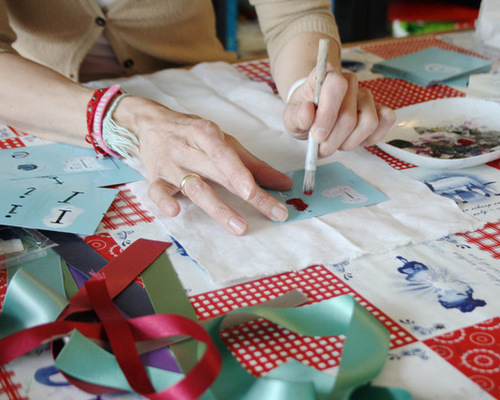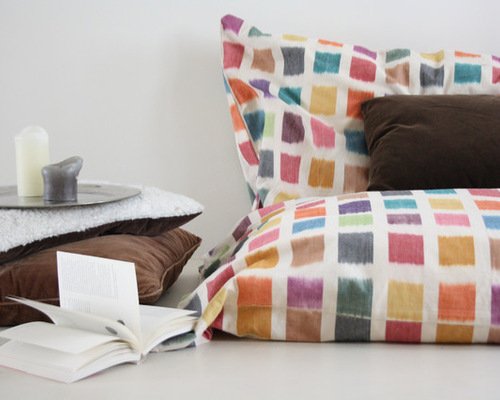Making something by hand, whether it’s a knitted cozy for your favorite coffee mug, a table you built yourself or a hand-stamped card, creates a feeling of satisfaction that buying something in a shop simply doesn’t. If you’ve caught the crafting bug or are curious about trying out a craft or DIY home project, the hardest part of all may be committing the time to pursuing your idea. But in the midst of a busy life, the balance that engaging in a homemade, unplugged pursuit can bring is well worth it. At the end of an hour of creative time, you will likely feel mentally refreshed and revived … now that’s something TV can’t do for you!
Check out these tips for getting inspired, setting up your space, choosing a project, getting help and connecting with like-minded others.
Find your medium and get inspired. Before choosing a project to work on, it helps to explore with an open mind. The world of crafts is your oyster! Dive into a great big pile of art, craft and design books and magazines, browse the Houzz DIY section, visit the library or a well-stocked bookstore, and see what catches your eye. Did you once learn a craft, like knitting or sewing, and drop it? Pick it up again — or try something completely different.
Here are a few ideas to get your creative juices flowing:
– Sewing and fiber arts: knitting, crocheting, embroidery, needle felting, sewing, quilting
– Paint, collage, mixed-media, paper crafts
– Furniture rehab
– Decorative paint techniques
– Woodworking and building

Set up your space. Once you’ve zeroed in on a craft you want to explore, carve out the space to do your work. We’ve all drooled over those amazing photos of dream studios and workshops, but the truth is, you don’t need a massive space or fancy new furniture to get started. Work with the space you have available and pull from furnishings you already own. Making do is better for the creative spirit anyway.
Choose a project. Now is the time to choose what you will work on first. Choose something that is calling out to you — something that is inspiring yet also looks doable. If you are realistic about your skill level, you will have better results. If you want to learn about furniture rehab, for instance, start by painting a small flea market cabinet and lining the doors with pretty fabric, not reupholstering an armchair.

Be patient with yourself … and take plenty of breaks. Creative work can be fun, but crafting also has its moments of pure terror. Too strong a word? If you’ve ever been a dozen hours into a crafting project and realized you’ve been doing it all wrong, you might not think so. Be kind to yourself and expect things to not go smoothly 100 percent of the time.
Much of crafting work takes intense concentration, so remember to weave in regular breaks. Put on music you love, sip a cup of tea, go for a walk and then come back to your project, refreshed and renewed.

Get help. When things really go awry, it can be tempting to throw in the towel. But if you have been enjoying your creative time, there are still ways to salvage your work if you choose to. The ideal choice is to find a local craft studio — a place that offers workshops and classes is best, but many fabric, yarn and home improvement stores can be a great help, too. Call ahead and see if you can bring in your project to get help with a tricky part.
If there is nothing available locally, then it’s time to hop online and find some virtual support. There are many blogs and online communities (Ravelry is the go-to help spot for knitters) willing and ready to help out a crafter in need. There are also tons of free how-to videos out there; a quick search should turn up a bunch.
Use what you have. It is shockingly easy to spend lots of money on craft and DIY project supplies. Rein in spending by searching your own home for supplies before hitting the store — get creative and challenge yourself to come up with a project using just what you have at hand.

Share your handiwork. When you finish a project, snap a few photos of your work. Upload them to your Houzz profile to share with the community. If you have a blog, you could share the photos and a bit about your process in a blog post. But even if you don’t have a blog, sharing your work in an online forum with like-minded crafters can be a real boost.
Host a crafting group. What’s more fun than working on a knitting, crochet or DIY project on a rainy evening? Doing it with a group of friends who share your passion. If you are starting your own group, you can make the rules — think about whether you want to limit it to one craft or keep it open to whatever members want to create. You could take turns leading the group in making a project workshop-style or leave it free form.
No matter how you structure the group, set out some tasty snacks and beverages, and provide seating that is appropriate for the type of craft you will be working on. Knitters can plop down anywhere, but other project work may require table space for spreading out materials. Plan ahead to have the right furniture and gear available.

Keep a craft and DIY notebook. If you enjoy making things, it can be quite helpful to keep track of what you make, as well as a list of what supplies you have on hand. As your stash grows, it will become easier to buy more of the same materials you already have, simply because you forgot they were there. You can also use your notebook or ideabook to jot down ideas for future projects, and notes to refer to if you make the same project a second time.
Original article written by Laura Gaskill on Houzz


